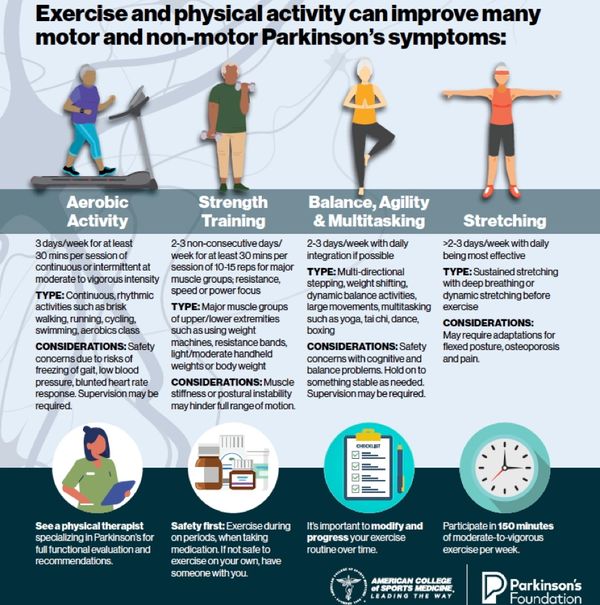Parkinson's and Exercise
Exercise is strongly recommend to help with motor symptoms and voice problems. Recent research has shown that some types of exercise can change the structure and function of the brain, and reduce the need to take medication (Van der Kalk et 2019, Johansson et al. 2022). There is increasing evidence that exercise may have a neuroprotective effect, meaning that it can slow the progression of the condition, particularly if introduced early after diagnosis. Exercise is medicine!

Useful Links For Exercise information
Parkinson's UK
Physical activity and exercise | Parkinson's UK
MJ Fox Parkinson's Foundation
MJ Fox produced an extensive guide to exercise and parkinson’s in January 2024- link to download The chart below on how much exercise you should do comes from their guide
Parkinsons Foundation US Have also produced a very useful guide on exercise called "Fitness counts" with examples of exercise that you can do at home. You can download it here- I can recommend the fitness Friday videos from the PD Health @ Home series
(scroll to bottom of page!)
Parkinson’s Europe also has a very informative site-
Watch Professor Bas Bloem's inspiring talk about the importance of exercise in improving Parkinson's symptoms (Oct 2022)

Types of exercise considered to help with PD symptoms
1. Exercises that emphasise strength, power, big movements (e.g PWR!Moves, PD Warrior and other physio designed classes)
2. Aerobic work - new guidelines from clinical studies by neurologist Baas Bloem's group published in 2020 and 2022- show that you should do 30-45 mins 3 times a week of cardio work such as exercise bike, fast walking, running, swimming, kick boxing
3. Stretching exercises to maintain joint flexibility and reduce stiffness; including rotation of spine (e.g yoga, pilates)
4. Co-ordination (cognitive challenges) (e.g dance, tai chi, tennis, table tennis)
5. Balance and fine motor control (hand exercises, yoga, tai chi, pilates )
6. Flow-continuous movement (e.g Tai Chi, dance including ballet)
7. Counting as move; adding in facial expressions

How much exercise should I do?
This picture comes from a recent report by the American College of Sports Medicine and the US Parkinson's Foundation. This diagram and the table from the MJ Fox Doundation above can be daunting. The best approach is to choose exercise types that you like and will be prepared to commit to. Then gradually build up what you do and challenge yourself .

Cycling:
How Cycling Helps to Slow Down Parkinson’s Disease - We Love Cycling magazine
Cycling is very good for improving aerobic fitness. It can be done on an exercise bike so it's also suitable for those who worry about balance. This is a good article that shows how cycling can benefit people with Parkinson’s.

Examples of Specific Parkinson's Targeted exercise approaches
PWR!:
PWR! Moves – Parkinson Wellness Recovery | PWR!
PWR! is mostly used in America, but in London there are three teachers (one of whom is me). The PWR!Moves exercise curriculum is specifically targeted at Parkinson's symptoms It targets moving big and with power; adding coordination and making exercises functional (i.e. related to daily activities that may become difficult with PD).
PD warrior
https://pdwarrior.com/ Similar philosophy to PWR! and often offered by local NHS Trusts/Hospitals in a 6-8 week course.
There are many other classes in gyms and the community; some of us have particularly enjoyed Ballet for Parkinson's taught in the London area by English National Ballet and Ballet Boyz in Kingston

Movers and Shakers Podcast
Movers & Shakers: six familiar faces host podcast about living with Parkinson’s - Cure Parkinson's
"A group of six friends living with Parkinson’s regularly host a podcast to raise awareness of the condition. 'Movers & Shakers' shares the challenges and positives of their Parkinson’s experience through informative, open and often hilarious conversations. The group touch on research news and interview their own specialists and international experts on different aspects of the condition."
TwoParkies in a Pod Podcast
Parkinson's Podcast | 2 Parkies In A Pod
"If you want to know more about Parkinson's, or how to cope with chronic illness, then this is the Podcast for you. Between them Clarky and Kuhan have been living with Parkinson’s for more than 20 years. They chat openly and honestly about the challenges and even the benefits of living with the condition."

Research- clinical trials that Show the benefits of exercise for people with Parkinsons
Aerobic clinical results study :
press release from Parkinson's UK Jan 2022
Researchers in the Netherlands (Baas Bloem's group) have discovered that regular exercise may improve Parkinson’s symptoms by creating connections between areas of the brain affected by the condition. The research involved a study called Park-in-Shape that compared the benefits of vigorous exercise to stretching over six months.
One-hundred-and-thirty people took part, with half cycling on a stationary bike and the other half stretching, three times a week for 30-45 minutes. People in the exercise group were instructed to cycle at 50-80% of heart rate reserve. The study highlighted that strenuous exercise may change the structure and function of the brain. After six months, people in the exercise group developed more connections between important brain areas and performed better on cognitive tests. Similar benefits were not seen in the stretching group.
Source: Johansson et al. 2022; Aerobic Exercise Alters Brain function and Structure in Parkinson’s Disease:A Randomized Controlled Trial. ANN NEUROL 2022;00:1–14
and van der Kalk et al 2019 Effectiveness of home-based remotely supervised aerobic exercise in Parkinson’s disease; a double-blind randomised controlled trial. The LANCET http://dx.doi.org/10.1016/S1474-4422(19)30285-6
Copyright © 2025 LiveWellExercise - All Rights Reserved.